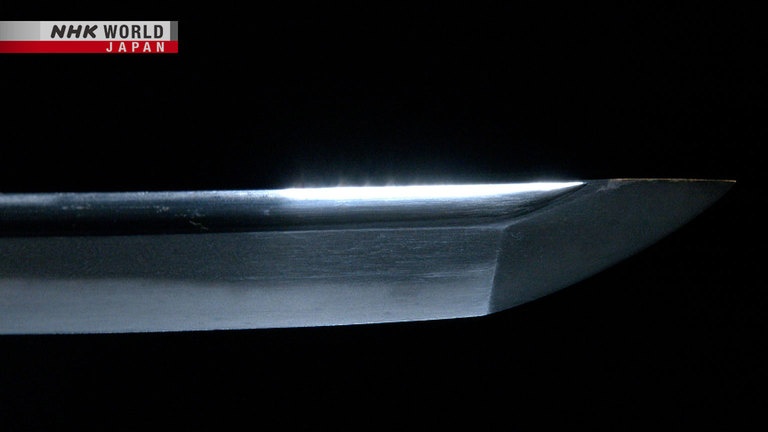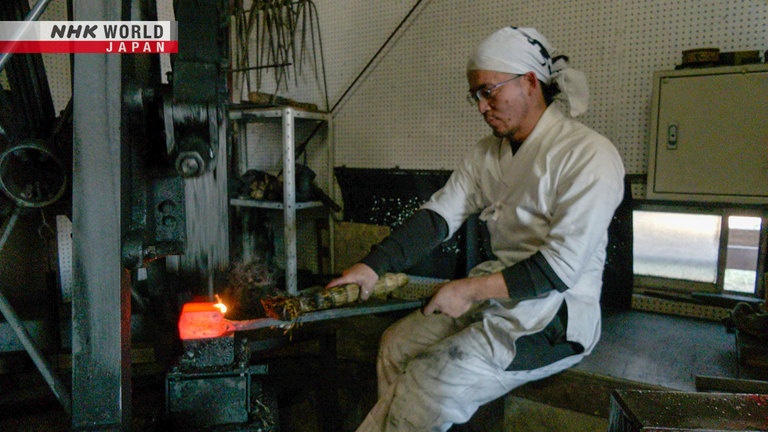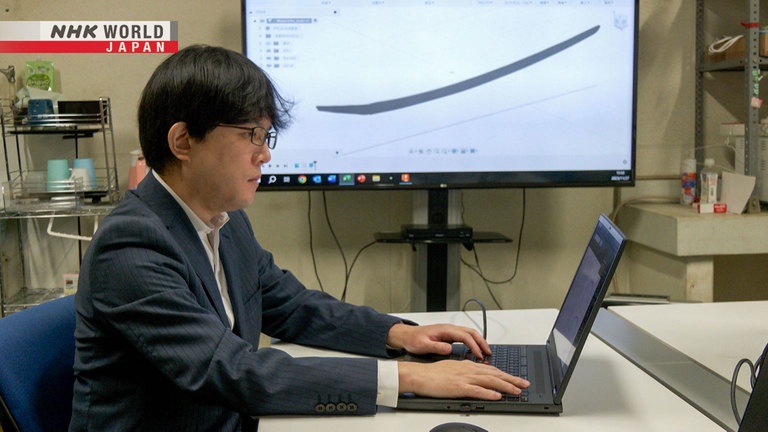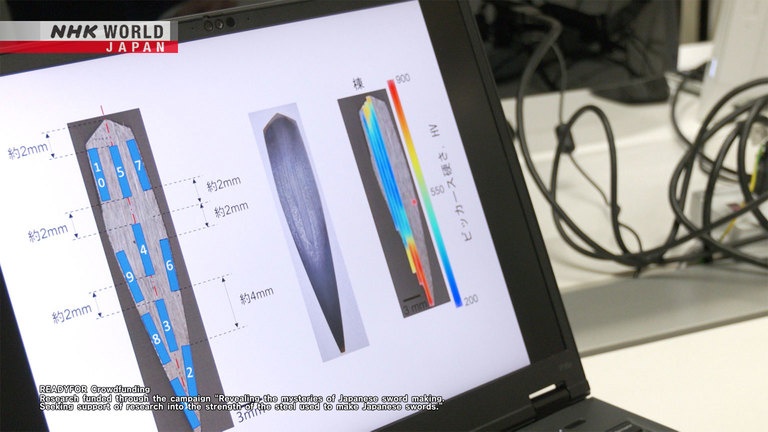The Secret of Japanese Swords
Japanese swords are called "metal made art." The once lost techniques used to make them prior to the 16th century are now on the verge of rediscovery.




Transcript
The Japanese sword...
Awesome functionality honed into a graceful form has led them to be called metal made art.
They're known to be unbending, unbreaking, and keenly sharp.
Over a history stretching back more than a millennium, countless expert swordsmiths have furthered the craft.
And yet, one period of this lineage is shrouded in mystery.
Methods used in the 16th century and earlier have been lost, the details of their techniques now unknown.
What kind of materials were used, and under what circumstances?
Researchers have worked to uncover the truth behind these swords.
There's something enigmatic about them.
The more we analyze them,
the more we realize the complexity.
I think that incredible depth may be their greatest appeal.
Japanese swords, embodying the spirit and mastery of their creators.
In this episode, we use science to unsheathe the mystery within the metal.
Gifu University. It is here that the science behind Japanese swords...
is being pursued by a devoted researcher.
We'll focus on the role of science in making Japanese swords.
Nakata Toshiya is an associate professor specializing in the study of material strength.
He had previously researched materials for use in devices like automobile frames.
However, he's found a new source of inspiration.
A Japanese sword believed to have been made in the 16th century or earlier.
The blade is shrouded in mystery.
Our current knowledge of sword making is apparently
based on techniques from the Edo period.
Prior to that, the methods were probably
passed down verbally.
As such, we remain largely unaware of the details
of ancient sword making.
Swords resembling their modern shape are thought to have first emerged around the 11th century.
In the long years that followed, their functionality in cutting was progressively improved.
But in the 17th century, with the birth of the Edo shogunate, Japan entered an era of continuing peace.
Swords were valued less as weapons than as decorations.
The swords from previous eras came to be called "ancient swords,"
and the techniques for their creation were lost to the sands of time.
Nakata has made it his mission to seek out these lost methods.
What could have caused the methods for creating ancient swords to fade into history?
Exhibiting a wealth of weapons, the Japanese Sword Museum may hold some answers.
Most of the techniques from that era
were never preserved in writing.
Naturally they've been lost to the modern world,
or been rearranged at some point.
People seem to have added to them over time.
It's very hard to explain what's been retained from
early swords, and what's been added.
Sword-making techniques were passed down from master to apprentice,
shared only among a small number of people and never committed to writing.
These are the lost traditions that Nakata pursues.
He believes that the specific qualities of the metal are key to the solution.
Our swords are known for cutting sharp without bending
or breaking, but it seems that a lot goes into that formula.
I think that the strength of the inner steel
is very important to it.
Which parts are hard, and which parts are durable...
It was probably very carefully regulated.
One trait of Japanese swords is that a single blade contains different points
with varying qualities like hardness and durability.
Nakata believes that revealing these qualities might lead back to the traditional methods.
In this program, we closely examine two procedures that could play a role in realizing the swords.
The first is folded forging.
The second, quenching.
We witnessed the processes at a Japanese sword forge.
Hello.
This is sword maker Miyashita Masayoshi.
He showed us just what Japanese swords are made of.
This is called tamahagane.
It's the steel used in Japanese swords.
We use a traditional bellows method, burning charcoal
and making the blade from iron sand.
Tamahagane, Japan's unique form of steel made from iron sand.
It's softer and more flexible than the iron ore typically used for western swords,
lending Japanese blades their distinct properties.
This is where we forge it.
Forging involves taking the tamahagane and striking,
stretching, and folding it over and over.
Folded forging is a process developed exclusively for Japanese sword making.
First, a mass of tamahagane heated to over 1,000°C is struck with a hammer.
Then a slit is cut down the middle...
And it's folded in half.
The newly folded steel is hammered again, and then folded.
This repetition continues dozens of times.
Tamahagane is a mixture of various substances.
Impurities are removed by striking it, and its carbon
concentration is unified into steel.
Work continues for 3 days.
By repeating the process, folded forging imbues the strength for which Japanese swords are known.
The proof of the forging is marked on the blade.
The folding creates countless delicate patterns that artfully line it.
Layers just 1/1,000th of a millimeter in thickness are overlapped more than 30,000 times to form the complex patterns.
This process of folded forging that gives Japanese swords their strength is the same one to give their beauty.
After forging, the hot steel is cooled swiftly with water, in the process known as "quenching."
This crucial step is needed to give Japanese swords their sharpness.
However, within the reputation of being unbending, unbreaking, and keenly sharp, a contradiction is concealed.
To keep it from breaking, a blade requires durability and flexibility.
This allows force to merely warp it without breakage.
But to keep from bending, a blade must be hard.
Hard swords are also brittle when a certain degree of force is applied.
Sword makers are able to combine the contrasting properties of hardness and flexibility into a single blade.
The answer lies in changing properties brought by shifts in temperature: mastery of the science of steel.
To reveal the details, two cooling methods were compared.
We'll use carbon steel for the experiment,
adding heat to it.
For one, we'll cool it quickly using water.
For the other, we'll leave it out in the open
to cool gradually.
The first sample is heated to around 830 degrees, the approximate heat at which quenching is performed.
Then it's submerged in water to swiftly cool it.
After the temperature drops, the metal is secured.
Force is applied by adding 1-kilogram weights, one by one.
This is the fourth.
When a total of 4 kilograms are added, the metal finally snaps.
With the other sample, the metal is cooled gradually at room temperature, over the space of 15 minutes.
The metal's temperature drops.
Once again, weights are applied.
This time, when the weights reach 4 kilograms...
The metal bends, but doesn't break.
The only difference between these methods is cooling quickly or gradually.
Why might this distinction occur?
Steel is composed mostly from iron and carbon.
When it reaches a certain temperature, the carbon atoms move between the iron atoms.
If steel in this state is rapidly cooled...
The iron atoms contract, trapping the carbon among them.
The metal forms an extremely hard martensite structure.
When the metal is cooled slowly, the carbon atoms are allowed to escape almost entirely.
This forms the more durable pearlite structure.
The process of quenching forms both of these forms of steel at the same time.
The edge is cooled quickly to harden it, while the
other areas are cooled gradually to enhance flexibility.
By changing the cooling speed by location, it attains hardness
and flexibility that would normally be impossible together.
Quenching is performed simultaneously, raising the question of how the cooling times can be individually regulated.
The answer is an important step taken just prior to quenching.
A clay-like substance is being prepared.
This is quenching soil, made from a mixture including clay, charcoal, and grindstone powder.
Since the ingredients and their proportions have a direct effect on the quality of the sword,
the details are a carefully guarded secret.
Once the quenching soil is prepared, it's spread along the sword before quenching.
The key is applying it as evenly as you can.
You basically scrape the edge to make it thinner.
That thinner portion is heated to harden.
Areas where the soil is thinly applied grow hard.
In other words, changing the thickness of the soil directly affects the amount of time needed for the metal to cool.
The blade with quenching soil applied is placed inside the furnace.
The entire blade is heated uniformly.
Once the temperature has been sufficiently raised, it's submerged in water.
The sections where quenching soil is applied thinly cool quickly,
while the thicker areas retain their heat, cooling slowly.
This is the secret to making steel that has both hard and flexible portions.
The sword is complete.
The white wave-like markings upon the blade are known as blade patterns,
and are created as a result of the quenching soil.
They come from the technique carried down for over 1,000 years to make both a strong and aesthetically pleasing blade.
The method is based heavily in scientific properties.
However, the details of the materials and temperatures greatly affect the properties of the sword,
leaving the process for sword making in the 16th century and earlier to be largely a mystery.
We asked Miyashita: "If these techniques were revived in the modern world, would you like to use them?"
Of course. I'm not certain that I could totally recreate it,
but I'd like to try.
Many scientists are attempting to uncover the secrets of the ancient blades.
One among them is associate professor Tanaka Manako.
She explains that research of the swords has progressed since the early 20th century.
Observation was first made of the metal composition
of swords upon breakage.
Two people were prominent in the research.
One was Prof. Chikashige of Kyoto University.
He analyzed Western and Eastern metallurgy, including
Japanese swords, and published "Oriental Alchemy."
Within the book, he wrote observations made
of the metal composition of the swords.
It used the then cutting-edge utility of the microscope to examine cross sections of the swords.
Differences in hardness and impurities were drawn out by hand.
It was the first text to illustrate the inner structure
and metal composition of Japanese swords.
The other was Prof. Kuniichi Tawara
of the University of Tokyo.
Scientific research on Japanese swords
had begun during the Taisho period.
A forge for the swords was built inside the university,
where they actually made them and examined their compositions.
This data shows the composition found in sections of the blades.
Levels of phosphorus, sulfur, and manganese clearly reveal the structure of tamahagane within it.
Tanaka is currently working on a process to analyze Japanese swords without breaking or damaging them.
Neutrons, known for their ability to pass through matter, can be used in data analysis.
They're expected to reveal qualities of steel
such as the crystal structure and size, condition, and inner effect of quenching.
We take the time gaps until the emitted neutrons reach
the equipment.
The time is changed into wavelengths to observe
the inner structure.
These images display a sample analyzed directly before and after quenching.
Before quenching, it's blue like this.
Afterward, it turns red.
It shows that the metal composition changes
through quenching.
It isn't something visible to the naked eye.
Permeating the material with neurons lets us glimpse
changes in the inner crystal structure.
Tanaka views Japanese swords as a research subject holding great scientific appeal.
The research reveals the hidden ingenuity of generations
of sword makers.
I think that to researchers, that's the most alluring aspect.
Meanwhile, Nakata has made great efforts to decode the process in creating historical swords.
In April 2022, he launched a crowdfunding project to begin individual research.
He began with a preliminary experiment on a modern Japanese sword.
It measured the hardness throughout the blade.
These were the results.
This shows a cross-section of the sword, with the lower area being the edge.
The red sections are the hardest, with blue sections becoming softer.
Nakata's experiment shows the edge to be extremely hard,
but the area just a few millimeters from it to grow progressively softer.
To perform even deeper analysis, various cross-sections were removed...
From these, the strength of the steel was measured.
The numbered sections are where samples were taken from.
In this experiment, the upper part is pulled vertically,
applying force to shift the narrow section.
We tested how much force is necessary, and how much
it stretches the narrow section.
This is the actual sample.
In order to accurately gauge the degree of strain when pulled, it's been machine-cut into this shape.
The sample is pulled vertically, examining the warping of the metal.
It was discovered that samples from near the edge would not significantly stretch,
but rather break when a threshold of force was exceeded.
By contrast, samples taken from the interior or sides stretched significantly, and were less prone to breakage.
Japanese swords are known for being resilient and sharp because
the edge is hard while other areas are somewhat flexible.
This gives them the trait of cutting sharply while also being durable.
The tensile properties differ totally by position because
they depend on the heat treatment conditions.
This should provide an indicator to assume those conditions.
Nakata has concluded that the varying strength of the steel could reveal the ways
in which folded forging and quenching were performed.
He plans to conduct this experiment on actual ancient swords.
While his research has commenced from the smallest of samples,
Nakata believes that the research may hold great significance in the modern era.
Craftsmanship is in the midst of major changes.
Handmade work is being progressively replaced by machines
and AI, and it may become even more of a rarity.
In this day and age, mastery of handmade craftsmanship
could extend to various traditional manufacturing.
I'd like to convey what an amazing thing that is.
Japanese swords have attained a unique evolution over the course of more than a millennium.
Their mystery acts as a call to arms for researchers who wish to uncover the secrets of the swords.